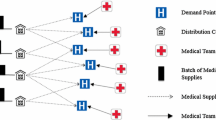Abstract
Pre-positioning of emergency supplies is a means for increasing preparedness for natural disasters. Key decisions in pre-positioning are the locations and capacities of emergency distribution centers, as well as allocations of inventories of multiple relief commodities to those distribution locations. The location and allocation decisions are complicated by uncertainty about if, or where, a natural disaster will occur. An earlier paper (Rawls and Turnquist 44:521–534, 2010) describes a stochastic mixed integer programming formulation to minimize expected costs (including penalties for unmet demand) in such a situation. This paper extends that model with additional service quality constraints. The added constraints ensure that the probability of meeting all demand is at least α, and that the demand is met with supplies whose average shipment distance is no greater than a specific limit. A case study using hurricane threats is used to illustrate the model and how the additional constraints modify the pre-positioning strategy.
Similar content being viewed by others
References
Atlantic Oceanographic and Meteorological Laboratory (2006) Frequently asked questions: E11) How many tropical cyclones have there been each year in the Atlantic basin? What years were the greatest and fewest seen? National Oceanic and Atmospheric Administration. http://www.aoml.noaa.gov/hrd/tcfaq/E11.html
Barbarosoglu G, Arda Y (2004) A two-stage stochastic programming framework for transportation planning in disaster response. J Oper Res Soc 55(1): 43–53
Charnes A, Cooper WW (1959) Chance-constrained programming. Manag Sci 6: 73–79
Chen G, Daskin MS, Shen Z-JM, Uryasev S (2006) The α-reliable mean-excess regret model for stochastic facility location modeling. Naval Res Logist 53: 617–626
Daskin MS, Hesse SM, Revelle CS (1997) α-Reliable p-minimax regret: a new model for strategic facility location modeling. Locat Sci 5(4): 227–246
Haghani A, Oh S-C (1996) Formulation and solution of a multi-commodity, multi-modal network flow model for disaster relief operations. Transp Res Part A: Policy Pract 30(3): 231–250
Houming F, Tong Z, Xiaoyan Z, Mingbao J, Guosong D (2008) Research on emergency relief goods distribution after regional natural disaster occurring. In: International conference on information management, innovation management and industrial engineering, ICIII, Taipei, vol 3, pp 156–161
Rawls CG, Turnquist MA (2010) Pre-positioning of emergency supplies for disaster response. Transp Res Part B 44: 521–534
Sheu J-B (2007) An emergency logistics distribution approach for quick response to urgent relief demand in disasters. Transp Res Part E Logist Transp Rev 43(6): 687–709
Author information
Authors and Affiliations
Corresponding author
Rights and permissions
About this article
Cite this article
Rawls, C.G., Turnquist, M.A. Pre-positioning planning for emergency response with service quality constraints. OR Spectrum 33, 481–498 (2011). https://doi.org/10.1007/s00291-011-0248-1
Published:
Issue Date:
DOI: https://doi.org/10.1007/s00291-011-0248-1




